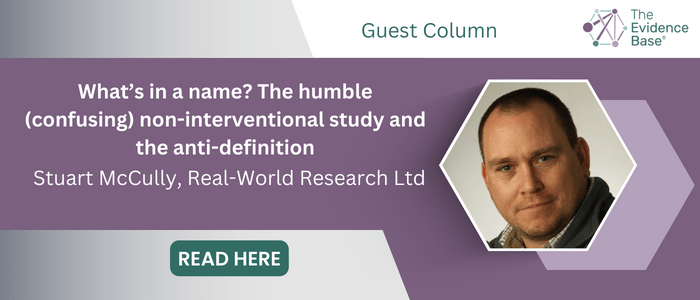New EMA reflection paper advances conversation around use of real-world data in non-interventional studies

EMA releases draft reflection paper on RWD in NIS for regulatory purposes, addressing methodological aspects and inviting stakeholder input until August 31, 2024.
The European Medicines Agency (EMA) have recently released a draft reflection paper titled, “Reflection paper on use of real-world data in non-interventional studies to generate real-world evidence.” The document, open for public consultation from May 3, 2024, to August 31, 2024, aims to advance the use of real-world data (RWD) in non-interventional studies for regulatory purposes.
A non-interventional study, as defined in the reflection paper, is a type of, “clinical study that does not fulfil any of the conditions defining a clinical trial in Article 2.2(2) of Regulation (EU) No 536/2014 on clinical trials on medicinal products for human use.” The paper underlines the significance of such studies in addressing regulatory questions, and outlines potential challenges and considerations involved in using RWD to generate reliable real-world evidence (RWE). Key topics discussed include feasibility assessment, bias, confounding, and data quality.
The paper focuses on the design, conduct, and analysis of non-interventional studies using RWD to generate RWE for regulatory purposes throughout a medicine’s lifecycle. It provides guidance in four main areas:
- Study design
- Governance and transparency
- Data quality
- Statistical analyses
Additionally, the paper emphasizes the importance of the ENCePP Checklist for Study Protocols and other applicable protocol formats in designing non-interventional studies using RWD. It also underscores the need for considering the HARPER protocol template for presenting information on study design, exposure, outcome, and covariates as part of the study design process.
This effort by the EMA aligns with the FDA’s publication of their draft guidance in March 2024, demonstrating a shared commitment to advancing RWE in regulatory decision-making. As Stuart McCully, in his recent guest column, notes,
“non-interventional studies – the often considered backbone study used in RWE research”
have differing definitions between the two regions, which can lead to confusion when discussing their use in generating RWE.
The 16-page draft document is open for public consultation until August 31, 2024, inviting input from stakeholders to refine and enhance the guidance provided. This initiative by the EMA not only highlights the importance of incorporating RWD into regulatory decision-making but also sets a framework for methodological rigor and transparency in non-interventional studies, contributing to the reliability and credibility of RWE.
You may be also interested in:
What’s in a name? The humble (confusing) non-interventional study and the anti-definition
The EMA’s reflection paper contributes to ongoing conversations about the methodological aspects of non-interventional studies using RWD to generate RWE for regulatory purposes. As the FDA’s guidance states, “a non-interventional study is a type of study in which patients receive the marketed drug of interest during routine medical practice and are not assigned to an intervention according to a protocol.” The draft guidance from the FDA also aims to help sponsors recognize and tackle common challenges in utilizing non-interventional studies, including identifying and addressing the presence of confounding and other forms of bias.
By providing a comprehensive framework for the use of RWD in non-interventional studies, the EMA’s reflection paper and the FDA’s guidance demonstrate a shared commitment to advancing the reliability and credibility of RWE in regulatory decision-making. The public consultation process will further refine and enhance the guidance, ensuring that stakeholders’ perspectives are incorporated to strengthen the methodological rigor and transparency in this important area of research.
Want regular updates on the latest real-world evidence news straight to your inbox? Become a member on The Evidence Base® today>>>







